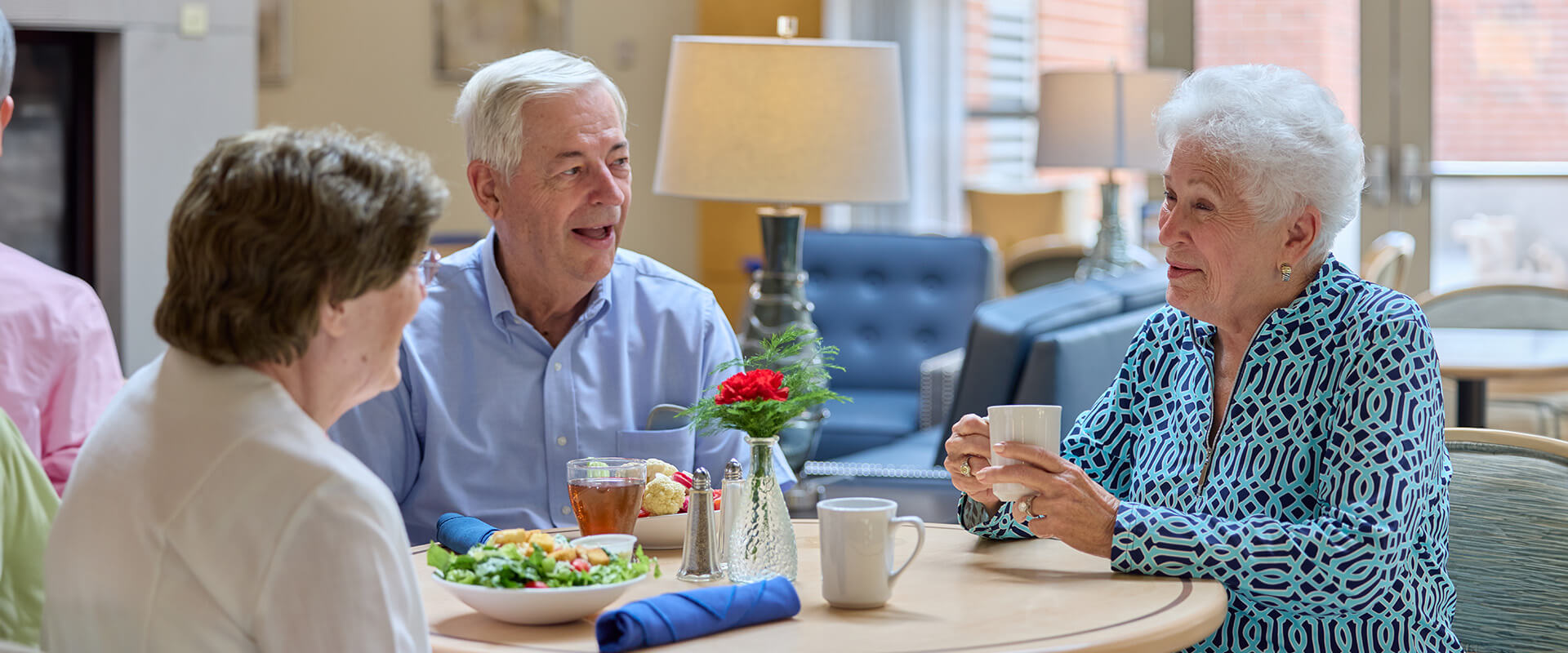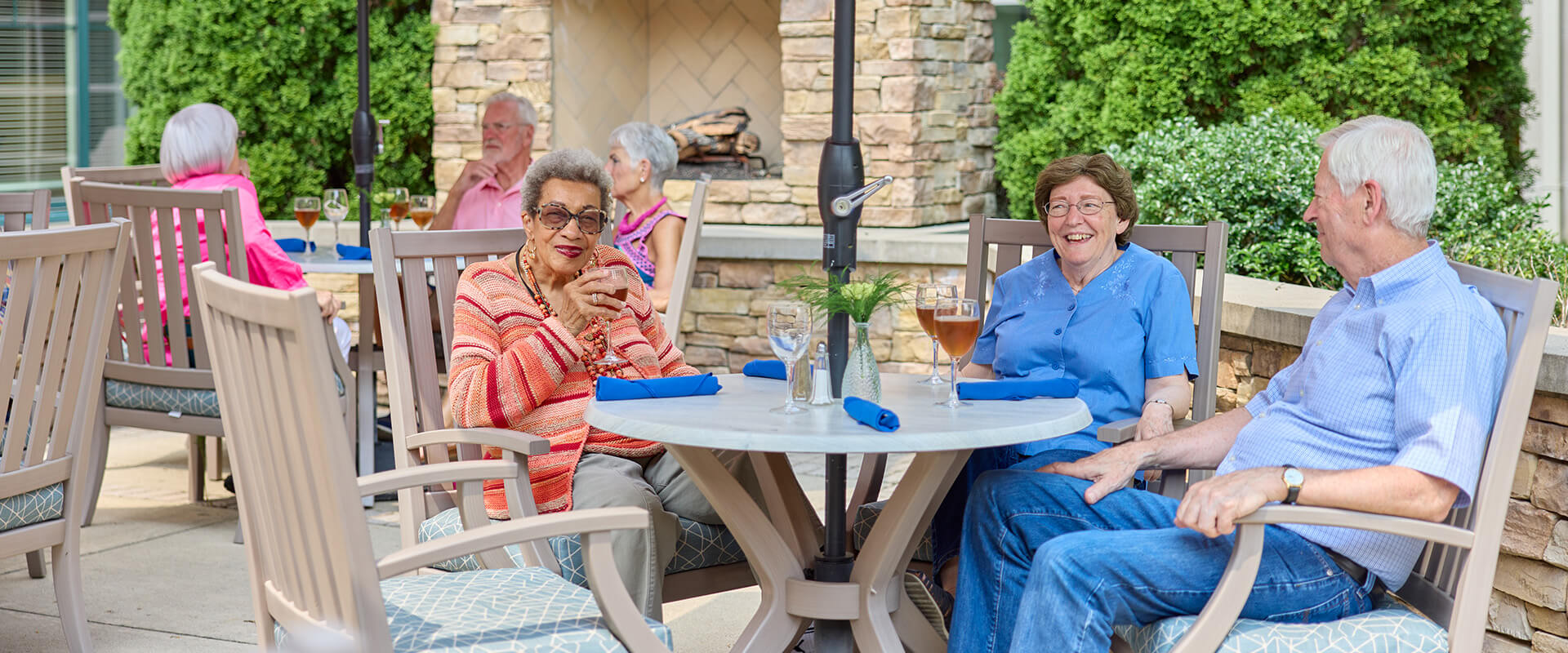Curious about independent living at a retirement community, but not exactly sure what that entails?
This essential guide is for you. Below, you’ll find helpful information on some of the most important things you need to know — including the many rewarding benefits you’ll experience, the different housing types available, and the most frequently asked questions about cost.
Just as the name implies, independent living communities provide the ideal opportunity to maintain your independence while enjoying a carefree lifestyle filled with resort-like amenities you might not have at home. The end result is greater overall well-being, an enhanced quality of life, and more fulfilling retirement years.
And that’s just the beginning. Here are a few more benefits:
A maintenance-free lifestyle. Independent living allows you to say goodbye to the burdens of maintaining a home. Communities like Marquette offer housekeeping and maintenance services that handle everything for you. Imagine not having to mow the lawn, shovel snow or arrange for your appliances to be fixed. Everything is now taken care of.
Restaurant-style dining. Cooking every meal? A thing of the past. Senior living communities provide delicious cuisine with a variety of nutritious options. At Marquette, our residents enjoy a choice of venues that include our formal Dining Room, our casual Fireside Gill, our lovely outdoor terrace, and private dining with family and friends,
A wealth of ways to stay healthy. Amenities like heated pools, saunas and on-site fitness centers equipped with the latest exercise machines make it easy to stay active. And this is often supported by a wide range of wellness programs tailored specifically for seniors — including seminars, nutritional counseling, yoga and fitness classes and personal training.
A vibrant social scene. Camaraderie and a full social calendar happen here. You’ll be able to mingle and make connections with recreational activities that often include barbecues, book clubs, art classes, dance lessons, movie nights, holiday parties, ice cream socials and much more.
Inviting outdoor spaces. Independent living communities typically boast beautifully landscaped grounds, including walking paths, gardens and courtyards that allow you to enjoy the outdoors without leaving your community.
Access to complimentary transportation. Many communities also provide you with reliable transportation for group outings and shopping trips. Visits to medical appointments and other errands can also be provided for a small fee.
3 Types of Independent Living Communities
Ready to explore your options for independent living? The first step is choosing a community that’s right for you. Here are the three main types:
- Active Adult Communities (also known as 55+ Communities). Ideal for seniors who are fully independent — preferring to live on their own but near each other, and looking for a lifestyle with minimal maintenance and plenty of recreational activities. Just like residents who live in a traditional apartment complex, residents here enjoy popular amenities like clubhouses for gatherings, fitness centers, pools, tennis courts and more. Active Adult Communities typically don’t offer any services beyond the building’s amenities.
- Rental Retirement Communities. Seniors in these communities are fully able to take care of themselves and perform daily tasks, but they’re ready for an even more simplified, carefree lifestyle. After an initial security deposit, residents pay a monthly fee that includes rent as well as services not offered at Active Adult Communities — such as prepared meals, housekeeping and transportation — while enjoying amenities and community living with others. Many Rental Retirement Communities also offer on-site assisted living and memory care services as well.
- Continuing Care Retirement Communities (CCRCs), also known as Life Plan Communities. Featuring a variety of residences on a large campus, this is a great option for many older adults. CCRCs allow seniors to have priority access to a full continuum of care for the rest of their lives. So as they move through retirement and their needs change over time, they can seamlessly transition to other levels of care without having to leave the community they call home. In essence, this provides the ultimate financial predictability and peace of mind. By paying an entrance fee, residents benefit from a guaranteed spot and lower cost for assisted living, memory care, skilled nursing and short-term rehabilitation if needed.
3 Types of Independent Living Housing Options
Once you’ve found your ideal community, the next step is choosing from three types of independent living residences:
- Senior Apartments. Perfect for the active older adult, this is the most popular type of senior housing — providing restaurant-style dining, full social calendars and an array of other amenities. Whether it’s a single building or a few buildings on a large campus, senior apartments typically range from a cozy one bedroom to a larger two- or three-bedroom unit.
- Cottages. Residents in these freestanding single-family homes enjoy ranch-style living in close-knit community neighborhoods — complete with a yard and attached one-car or two-car garage. It’s a great option for downsizing living space and remaining independent, while still enjoying shared amenities and convenient services.
- Garden Homes. Similar to cottages, these popular residences are independent living duplexes offering privacy, garages and front yards in a neighborhood setting. The main difference is that with garden homes, two units are separated by one joined wall.
Many senior living communities have also added a new style of residence to the mix called Hybrid Homes, which combine the best of cottage living with apartment living. Economically meeting the needs of seniors who want the space of a cottage but the footprint of an apartment, each Hybrid Home has its own community — essentially a neighborhood of small apartments — with underground garages and courtyards in between.
Independent Living Costs
Naturally, questions about cost often come up when exploring independent living community options — and of course your budget is always an important consideration as you look into different communities. Here are the financial questions we’re asked most frequently:
How much does independent living typically cost? Costs can vary depending on location, amenities and housing type, but they typically range from $1,500 to $6,000 per month — with the national median cost of an independent living community being $3,100 per month.*
What’s included in the monthly fee for independent living? The monthly fee often includes rent, utilities, maintenance, transportation, most meals and access to amenities and regularly scheduled activities. (It’s important to clarify what services and amenities are included in this fee and which are extra.) Many of our Marquette residents tell us that having everything under one monthly fee helps them simplify their expenses.
What’s an entrance fee? Continuing Care Retirement Communities (CCRCs), also referred to as Life Plan Communities, require a one-time entrance fee that guarantees a spot in the community and covers a portion of future care costs. Entrance fees and some monthly fees may qualify as medical expenses. Because these are potentially deductible if you’re itemizing deductions, this could result in a lower taxable income.
At Marquette, we offer the flexibility of a variety of entrance fee agreements to meet your needs and provide an option just right for you.
Are there any additional fees associated with independent living? Be sure to ask about extra charges for specific services like in-home healthcare, additional dining options or special activities that might not be included in the monthly fee.
Should I expect rent increases? Monthly fees can increase over time, so it’s crucial to understand the community’s policy on rent adjustments.*2024 Cost of Long-Term Care Report, A Place for Mom
Other questions we’re frequently asked at Marquette:
What factors should I consider when choosing an independent living community? Location is always important, as well as costs, amenities, community culture and the level of care available if you need it in the future. It’s a great idea to research online, visit communities and talk to current residents to get a feel for the environment and services offered.
How do independent living communities ensure the safety and security of their residents? Many communities like Marquette have emergency call systems, secure entrances and on-site staff available 24/7 to address any concerns or emergencies.
Can couples live together in an independent living community? Yes, many communities offer housing options suitable for couples.
Are there any age restrictions for independent living communities? Most communities have a minimum age requirement, typically ranging from 55 to 65 years old.
Can residents customize their living spaces? Most communities give you the opportunity to personalize your space with paint colors, window treatments and other decorative touches that make your home truly your own. Anything beyond that, such as a minor renovation, depends on the community.
Independent living communities truly offer something for everyone — a maintenance-free home, an enriching social life, countless ways to stay healthy and more.
Ready to declare your independence and design the lifestyle you want? We’d love to help you explore your options at Marquette, and give you a tour of our premier community in Indianapolis. Contact us today and one of our team members will be happy to schedule your visit!




